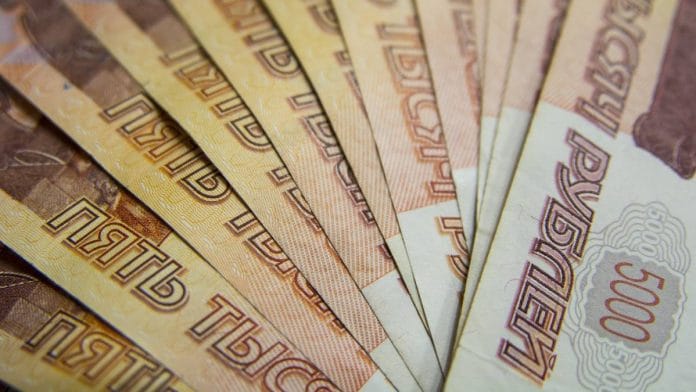New Delhi: As the historic sanctions from a group of Western nations kicked in Monday following its invasion of Ukraine, Russia’s markets froze after its sovereign currency, the ruble, nosedived 30 per cent. Russia kept the markets closed Tuesday.
The ruble’s exchange rate fell to 108 against the dollar Monday from 83 Friday, making it the currency’s worst single-business-day decline since 3 September 1998. For reference, 1 Indian rupee is equal to 1.32 Russian ruble, while a dollar is equivalent to approximately 75 Indian rupees.
The present crash in the value of the ruble is also unaidable, as sanctions have been imposed on the Russian central bank, preventing it from using its foreign exchange reserves to undermine the impact of the sanctions.
In response to the fall of the ruble, Russia’s central bank more than doubled interest rates to 20 per cent Monday, from the earlier 9.5 per cent, and banned foreigners from selling domestic financial assets to protect its currency and economy.
In a joint statement Saturday, countries including the United States (US), European Union (EU), France, Germany, Italy, United Kingdom, and Canada, had imposed a fresh set of sanctions on Russia’s central bank, and some other banks in the country, to exclude them from the SWIFT messaging system. The move is perceived to be stricter than the sanctions imposed earlier and is being seen as one which could potentially isolate Russia in international trade.
Also read: On Russia, PM Modi’s language isn’t too different from that of Nehru and India will pay costs
First major crash of ruble in 1998
The first major crash in the value of the currency, that was earlier known as the Soviet ruble, came in 1998, when the Russian government defaulted on its debt repayments. The incident is commonly known as the ‘ruble crisis’.
Seeds of the 1998 crisis were sown during the first war in Chechnya (between 1994 and 1996), which resulted in huge economic costs for the country. It was estimated that the war cost Russia $5.5 billion, close to 1.4 per cent of its GDP.
Internal political turmoil, clubbed with an Asian financial crisis, and the Russian government’s inability to implement reforms in 1997, led to investors pulling out their money from Russian assets, thereby selling rubles, which eventually led to a run on its central bank. This forced the Bank of Russia to use its foreign reserves to defend the ruble, which further eroded investor confidence and undermined the currency.
On 17 August 1998, the Russian government devalued the currency, defaulted on its debt payment, and declared a 90-day moratorium on repayment of foreign debt. The next month, Russia made the currency a free float, which meant that the exchange rate of ruble pegged to the dollar will be market-determined and not fixed by its central bank.
The recovery of the country and its currency was as rapid as its fall, as oil prices began to rise during the 2000s and Russia had a large trade surplus in that period. Another reason is that domestic industries, such as food processing, had benefited from the devaluation, which caused a steep increase in the prices of imported goods.
2014 financial crisis
The ruble had suffered a similar fall to what it’s facing now after Russia’s annexation of Crimea in 2014. Even then, the US, EU and other countries had imposed economic sanctions against individuals, businesses and officials from Russia, leading to a fall in the ruble’s value.
The other pertinent factor that had led to the fall in the value of the currency against the dollar then had been the rapid decline in oil prices in 2014, leading to investors pulling out their financial assets from the Russian markets.
Crude oil prices had started declining because of the boom in the American shale oil production. The price of global crude oil fell from $100 per barrel in June 2014 to $60 per barrel in December 2014. Since the Russian economy is heavily dependent on oil exports, it suffered a severe blow from the fall in the prices in 2014.
Because of these two factors, the ruble depreciated and, as a result, increased the borrowing costs for Russian companies. To repay their debt, the companies had to shell out more ruble for their dollar payments. In March 2016, the ruble was devalued more than 50 per cent from July 2014.
(Edited by Poulomi Banerjee)
Also read: How CIA & Chinese PLA joined hands in secret Cold War op to snoop on Soviet Union nukes






